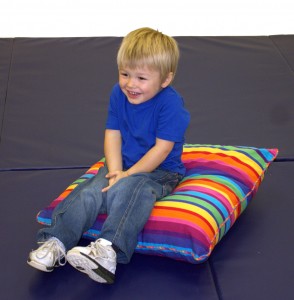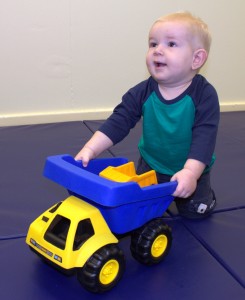
Children usually begin to speak by learning lots of names of objects and people as well as some functional words such as “up, more, gone”. In order to move from single words and phrases on to true sentences children need to learn to use verbs or action words. These combine with names of items and people to form sentences.
There are different types of action words. Children begin by learning concrete actions that they do and see in their daily lives such as: run, jump, sleep, eat, and draw. Some verbs are less concrete such as: see, go, hear, like, say and look. Cognitive verbs talk about what happens in your head such as: think, decide, wonder, want and guess. Words such as “is, be and are” are verbs too.
Sentences begin either:
“action” + “object/person” such as “eat the apple” or “hug mummy”
or “object/person + action” such as “rabbit eats” or “Ben hugs”.
Children then begin to combine these into the form “person/object + action + object” such as “rabbit eats the apple” or “Ben hugs mummy”.
Finally children add descriptive words about how the action is done such as “the big rabbit eats the apple quickly” or “Ben hugs mummy everyday”.
Later they will begin to use conjunctions (joining words) to link sentences together "I went to the shops and we had an ice cream".

Here are some activities to practice at home to develop the use of action sentences:
1. In everyday activities eg: dressing, bathing, eating, shopping, housework talk to your child about what you and your child are doing, “look mum is cutting the carrots and peeling the potatoes”.
2. Look at pictures in books and talk about what people are doing. Books with simple bright pictures of children playing and doing familiar activities are good.
3. In favourite games and daily activities model action words in sentences.
Craft: draw, colour, cut, glue, sprinkle, spread, stir, stick, peel.
Playdough: roll, squeeze, poke, push, kneed, cut, stretch.
Cooking: mix, cut, stir, spread, taste, smell, lick, bite, chew.
Bath time: wash, splash, scrub, pour, drip.
4. Use dolls, plastic animals, teddies, or figurines to act out actions as you model the words, “look teddy is dancing, puppy is hiding”.

As your child begins to use sentences use modelling to help your child learn correct sentence structures.
To give your child the best possible model:
- Speak clearly
- Use short, easy to understand sentences
- Be a good listener and use eye contact while speaking
- Use facial and body gestures to support what you are saying and make your message clearer.
You can also use modelling to help your child correct their errors. In this case let your child hear how the sentence should be produced without pointing out errors. Children who constantly have their errors pointed out will often stop trying.
- Don’t expect your child to repeat after you when you model, let them ‘listen and learn’
- Try to repeat the corrected word multiple times to speed the rate of learning
- Your model might sound like this: eg: If your child said "the boy fast running" you would model: "Yes, the boy is running fast".
Place a little bit of emphasis on the corrections, but don't overdo this. By modelling the correct form back to him, he is getting the chance to learn the correct sentence, and will later begin to use the correct sentence.
As your child begins to use sentences you can also use "expansion" to gradually extend the length of their sentences. This means adding an extra word or phrase to their sentence. If your child says "the boy is running fast" you might say "the little boy is running fast" or "the boy is running fast up the hill".

Children begin to combine words together at around 18 months of age and are confidently combining two words by two years of age. They are speaking in sentences by three years of age though grammar may still need some refining. If you are concerned about your child's speech development you may wish to look at the checklist for your child's age on our website. Speech and language delays put children at risk of learning difficulties later on and early intervention is most effective. To find out more about how speech pathology can help your child's development click here.
Talking Matters provides speech pathology, occupational therapy and psychology services to kids of all ages in Adelaide, South Australia. To find out more about our team and what we do browse our website and see how we can help your family.
There is also more information on our Facebook page, Twitter, or Pinterest.
Related posts:
Resources for kids
Active communicators
Baby play
Communicating choices
Two year olds
Developing vocabulary
Developing concepts
Developing play
Developing first words
Beginning questions
About 18 month olds
Related Blog Posts
If you liked this post you may also like:
Weekend play dough
2 1/2 year olds
Games for Travelling
Language assessments



